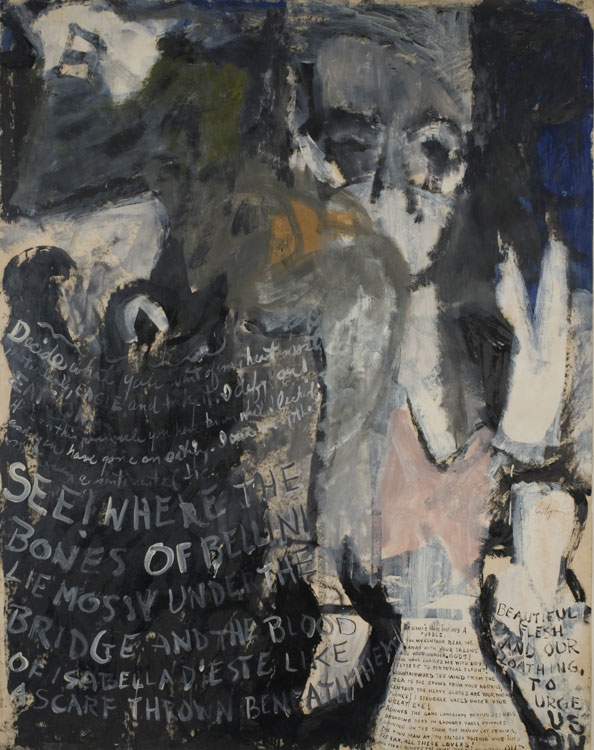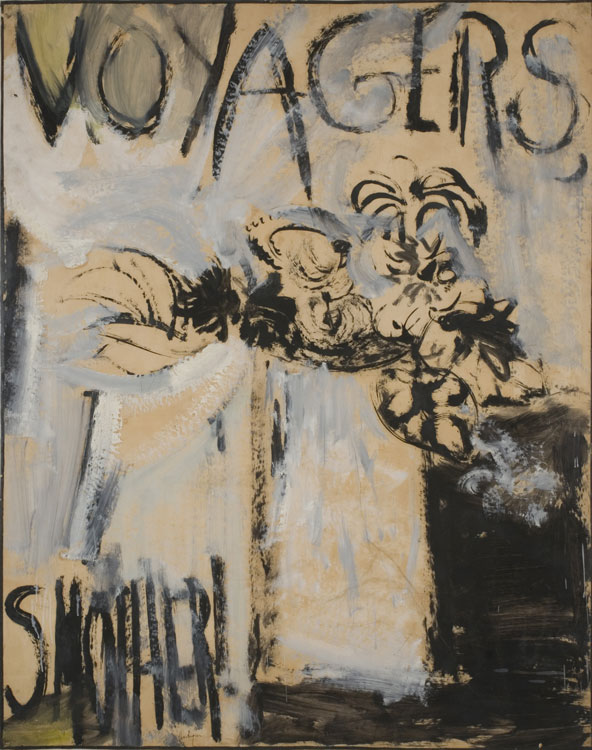One of my favorite arts-related quotes comes from Matt Berninger -- lyricist and frontman for indie rock band The National -- who had this to say about his song lyrics: "Without the music they don't work. They'd be like a dress without the girl."
The quote itself demonstrates Berninger's point. The words evoke a stirring image, one that is inextricably linked to the words. If one could separate the image from the words, they would be rendered meaningless. While the relationship between words and music in a song is an obvious example of two distinct mediums operating in a codependent manner to imbue each other with meaning, the connection between words and image is perhaps more subtle, as a result of its ubiquity in everyday living -- but no less moving.
With its Painters and Poets exhibition, New York's Tibor de Nagy Gallery goes a long way in illuminating the relationship. How can poetry embody the painting? How can the painting encapsulate the essence of the poem? Two works featured in the exhibition -- "Oranges no. 5" and "Oranges no. 11" (each work from 1952, oil on paper, 44 ½ x 35 inches) by painter Grace Hartigan with words from poet Frank O'Hara's "Oranges: 12 Pastorals" -- offer stimulating answers to those questions. In both works, the text gives the viewer the impression of manic haste, and desperate urgency seems to inhabit every letter. Bold, impassioned strokes smear and splatter across the paper with textured grit. The overall effect is rough-hewn, but there is an inherent intellectual precision at work.
 "Oranges no. 5," Courtesy Tibor de Nagy Gallery, New York
"Oranges no. 5," Courtesy Tibor de Nagy Gallery, New York
In "Oranges no. 5" (1952), Hartigan squeezes the entirety of O'Hara's eponymous poem onto the paper, and swathes of darkness swell around the text with ambiguous intent. What appears to be an abstracted, gray face is veiled, projecting a sorrowful disposition that dampens even the brighter whites in the painting with an unspoken, sober reality. The poem itself seems to simultaneously revile and revel in the lovely, doomed fate prescribed to humanity: "And for us always the same terrible mountain, our beautiful flesh and our loathing, to urge us on." Hartigan's muted, dark color palette of blacks, blues, beiges, grays and greens, the amorphous forms, and the ominous brushstrokes all speak -- without utterances -- to the emotional essence of O'Hara's words.
 "Oranges no. 11," Courtesy Tibor de Nagy Gallery, New York
"Oranges no. 11," Courtesy Tibor de Nagy Gallery, New York
In "Oranges no. 11," the opposite effect is achieved: here the words reveal deeper meaning in the paint. This is even more remarkable because, unlike in the previous painting, Hartigan chose only to include the first and last words of the poem -- "voyagers" and "smother." O'Hara's vision of inescapable human fallibility is once again present in the complete text: "...I must confess that the poor have me always with them, and I love no god. My food is caviar, I love only music and my bed is sin. Protected souls, where love and honor gleam through the window I am a stranger." This time, however, his words are stubbornly resolute -- the author owns his perceived faults with boldness and strength, whereas "no. 5" projects helplessness and comparative apathy.
Beige and gray dominates the painting itself, functioning almost like a kind of raw whiteout, as if blocking the complete text of the poem from view. The darkness that was prominent in "Oranges no. 5" seems to recede, and what appears to be the hollyhock -- the "favorite flower" mentioned in the poem -- is the focal point. The whole thing smacks of forbidden graffiti, but like O'Hara's words, there is no apology forthcoming. Instead, blurry movement permeates the paper, swirling around the flower. The viewer is left to ponder those two cryptic words: "VOYAGERS....SMOTHER!" Hartigan does true justice to O'Hara's words. Even by including only two of them in the painting, she illustrates their power to enhance one's experience of the visuals. The text seems to scream out from the paper, "Fulfill your fate!" and the paint obliges with a gorgeous dreariness. In the end, we are who we are, the artwork does what it does, and life is what it is. Beyond that, the words fill a compositional hole in the work, serving as border to the flower in the center.
Unsurprisingly, if there is any conclusion to be made, it is that there is no conclusion. But there can be clarity, something that Grace Hartigan and Frank O'Hara demonstrate with exuberance and alacritous poignancy.
The exhibition Tibor de Nagy Gallery Painters and Poets -- including "Oranges no. 5" and "Oranges no. 11" -- is on view at Tibor de Nagy Gallery, 724 Fifth Avenue, New York City, through March 5. For more information, visit http://www.tibordenagy.com.
